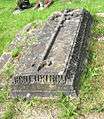Llandyssil
| Llandyssil | |
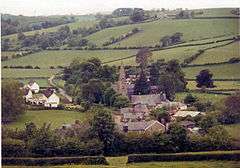 Llandyssil in 1971, looking north |
|
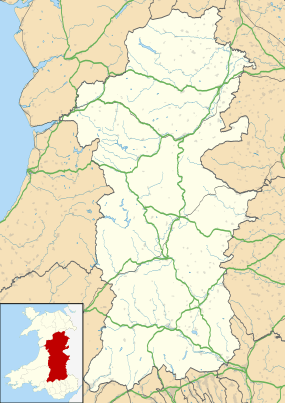 Llandyssil |
|
| Population | 1,527 (2011)[1] |
|---|---|
| Principal area | Powys |
| Country | Wales |
| Sovereign state | United Kingdom |
| Post town | MONTGOMERY |
| Postcode district | SY15 |
| Dialling code | 01686 |
| Police | Dyfed-Powys |
| Fire | Mid and West Wales |
| Ambulance | Welsh |
| EU Parliament | Wales |
| UK Parliament | Montgomeryshire |
Coordinates: 52°33′00″N 3°11′10″W / 52.550°N 3.186°W
Llandyssil is a village in Powys, Wales, about two miles from the town of Montgomery. The village is within the parish of the same name; in 2001 there were 420 inhabitants in the parish, of whom 300 live in the village itself.[2][3]
Neighbouring Settlements
| Bettws Cedewain Dolforwyn | Berriew Garthmyl | Caerhowell Forden | |
| Abermule Llanmerewig Aberbechan | |
Montgomery Churchstoke | |
| |||
| | |||
| Kerry Sarn |
Llandyssil and its connection with Celtic Saints
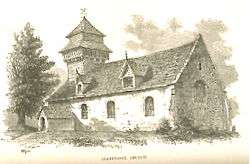
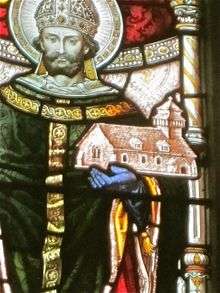
Llandyssil takes its name from St Tysul, a little known Welsh saint of the 7th century AD.[4] Only two churches in Wales were dedicated to this saint, Llandyssil in Montgomeryshire and Llandysul in Ceredigion and the feast day for this saint was celebrated on 31 January.[5] The old church in the village (largely demolished in 1866) stood in the graveyard to the SE of the present village. This suggests that the present settlement dates back to the period around 700AD. There is also a connection with another early Welsh and Breton saint, St Padarn.[6] On the highland to the south in Cefn y Coed, is the farm Cwm Badarn. The Llandyssil Brook rises in this Cwm or valley, and between Cwm Badarn Farm and the Pinion, is a rock cut spring, that was possibly a Holy Well, dedicated to St Padarn.
Administrative History
In the Medieval period Llandyssil was in the Cantref of Cedewain in the Kingdom of Powys. The parish was divided into four townships: Bolbro, Bronywood (or Bronycoed), Bryntalch and Rhandir. Rhandir, which contained the parish church, was the largest of these townships. It was probably an amalgamation of three other townships; Cefn-y-coed, Coedywig and Trefganol.[7] In 1536 following the Act of Union Llandyssil became part of the new county of Montgomeryshire. For ecclesiastical administraration the parish was in the Bishopric of St Asaph, the Archdeaconry of Montgomery and the Deanery of Cedewain.[8] For Parliamentary representation Llandyssil fell within the County of Montgomery until 1885, when for electoral purposes, it was included within the Montgomery Boroughs. It was transferred back to the County in 1918, when only one MP represented the Montgomeryshire. With the establishment of the Montgomeryshire County Council in 1894 Llandyssil Parish Council was created, and it was included in Forden Rural District Council. In 1974 as a result of Local Government reform Llandyssil Parish Council became a Community Council within the Montgomeryshire District Council.[9] At this time Llanmerewig was joined with Llandyssil to form the new Community Council and in 1984 this was renamed Abermule with Llandyssil Community Council. At this time, the Community Council covered the old parishes of Llanmerewig and Llandyssil, together with Dolforwyn, which had been a township in Bettws Cedewain parish. In 1996, with the abolition of the Montgomeryshire District Council], the Community Council became part of Powys County Council.
Population and Language
The Census returns are as follows:.[10]
- 1801-645
- 1811-758
- 1821-870
- 1831-914
- 1841-876
- 1851-808
- 1861-790
- 1871-830
- 1881-890
- 1891-704
- 1901-606
- 1911-626
- 1921-661
- 1931-572
- 1951-509
- 1961-520
In 1880 a portion of the township of Bolbro was transferred from Llandyssil to Llanmerewig and the size of the parish was reduced from 4187 acres to 3800 acres. This may be reflected in the decrease in population between the 1881 and 1891 censuses.
During the later part of the 18th century it appears that the Welsh language was supplanted by English for general usage in the village.[11] There are some Welsh speakers in the village, but they have mainly come from elsewhere in Montgomeryshire.
Archaeological and Historic Monuments[12]
Llandyssil is particularly rich in archaeological sites especially of the Later Bronze Age and Iron Age[13] To the NE it is overshadowered by Ffridd Faldwyn, possibly the largest Hillfort in Wales, which is adjacent to Town Hill in Montgomery. Most of the sites have been discovered by aerial photography. The main sites are:
Prehistoric[14]
- Brynderwen Enclosure.NGR SO2064995184 Ditched enclosure close to the river Severn. Late Neolithic Peterborough ware pottery. Dated to c.3350-3000 BC.[15]
- Cefn Llan Hillfort in Cefnycoed. NGR : SO20579476. Scheduled ancient monument. Enclosure situated on low hill comprising a sub-rectangular platform 60m by 40m (north-south) rising to c1.5m above the ditch. The original entrance is to the south. Site now overgrown and bank starting to erode.[16][17]
- Cefn Llan Enclosure (to N of Hillfort) Triple ditched enclosure c121m across, triple ditches only visible on the S side the rest being single or double ditched. Linear earthworks to SW could be related.[18]
- Cloddiau - Possible Late Bronze or Iron Age Cattle Krall or Banjo enclosure[19] with triple banks and funnel entrance[20][21] Triple ditched sub-circular enclosure 92 x 78m enclosing an inner area of 2526m. Well defined entrance to NE with flanking ditches. Excavations in 1993 showed the 4m wide inner ditch was just below the edge of the scarp but no stratigraphy survived either in the rampart or the interior[22][23]
- Coed y Wig hillfort.[24] NGR : SO1957096216. Iron Age Hillfort revealed by aerial photography. Possible enclosure, treble ditched to SE but only single ditch visible to E. NE part not visible. Site is set on 2 E-W ridges with a broad natural gully between. The ditches seem to be cutting across from one ridge to another
- Cuckoo Hill Hillfort[25] NGR : SO1829794715 3 ditched ovate enclosure 132.1 x 89.6m with no obvious entrance. Ditches to W show as cropmarks - those to E as parchmarks and slight earthworks. Defences spanning 31m. Located on low SW-NW ridge. Later house platforms cut into earthworks on SE side. Excavation 1993: triple ditched enclosure with earthworks surviving to c.0.2m high, the inner ditch was identified - width 3.7m. No stratigraphy was present. Single rim-sherd of probable Roman date from upper fill of ditch[26][27]
- Fron Fraith Wood Hillfort[28] NGR : SO1695893508. North-west part of two ditched enclosures, possibly circular with diameter c90m. The ditches are c5m across and there is a possible entrance gap on east. The enclosure is 110m NE/SW by 65m across. Excavated in 1994[26]
- Goron Ddu Hillfort[29] NGR : SO1860096570 east of Upper Bryntalch farm, on the crest of a short ridge, aligned north-east/south-west, overlooking the river Severn at an altitude of 200m OD, to the N of the village. The site consists of a double banked enclosure with widely spaced ditches. The inner ditch defines an approximately ovate enclosure measuring about 67m north-east/south-west and reducing in width from 62m at the south-west end to 40m at the north-east end. The outer ditch defines a sub-rectangular enclosure with rounded corners, measuring 131m north-east/south-west by about 95m overall. Geophysical survey has shown a concentration of features in the centre of the enclosure, but with insufficient clarity to distinguish round houses.[30]
- Mount Pleasant Defended Enclosure.[31] NGR : SO1898893669; scheduled ancient monument 1996. Double-ditched enclosure, 94.4m by 110m, with surviving earthworks, partly encapsulated in field boundaries. Excavation in 1994 identified the inner edge of the ditch, inside which were the remains of a clay dump rampart. Inside the rampart were remains of a hearth and grains of spelt wheat, and two post-holes which may have formed part of a four-post structure. Radio Carbon dates from the postholes of 2270-2330BP (Before Present), suggest that the site was occupied in the earlier Iron Age[32]
Roman
- The Roman Road from Forden Gaer/Lavrobrinta[33] to Caersws runs through the parish along the river, probably largely on the alignment of the B3484 from Caerhowel railway bridge to the Abermule railway bridge. During the construction in 2006 of the “Felin Hafren” housing estate in Abermule, a length of the Roman road was uncovered.
Early Medieval and Norman
- Brynderwen Motte and Bailey Castle guarding the river Severn crossing. An early castle on the Severn. The motte has gone and the bailey area is occupied by a farm[34][35]
- Cefn Bryntalch Motte and Bailey castle. To the SW of Cefn Bryntalch house. Earthen motte or ringwork at the NE end of a scarped natural ridge with a cross-ditch dividing it from the bailey[36][37]
- Mound by Llandyssil Bridge. Suggested barrow, but with flat top and more likely to be a medieval Mill mound. Place names in vicinity such as Cae Melyn and Ty Melyn (Originally Cae Melin and Ty Melin - Welsh for Mill Field and Mill House) may support its identification as a windmill mound for a Post mill.
Church and Chapel Buildings

- Old Church and Graveyard. The former church of St Tysul stood on the hillside overlooking the village. Now only a stone porch with an 18th-century doorway remains, standing in the churchyard. The single-chambered medieval parish church is shown in a woodcut illustration[38] to have been extensively rebuilt in the 18th century with round arched windows and roof dormers. It had also the most elaborate of the Montgomeryshire timber west bell-towers-a tower which was enclosed by an open gallery, corbelled out from the supporting framework, built inside the nave. Lych Gate to the graveyard by the architect Harold Hughes, of Bangor1907[39]
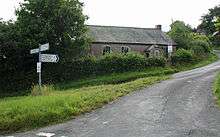 Bethesda Presbyterian Chapel
Bethesda Presbyterian Chapel - St Tysul. By the architect Thomas Henry Wyatt, 1863-6. Nave with west aisle, chancel, SE tower and spire. The church is orientated N-S rather than the usual E-W orientation. The four-bay arcade to the nave with polished red granite columns ?Shap Marble, with red sandstone and white limestone blocks used to decorate the stone arches. Chancel arch in Early English style. Caen stone and alabaster reredos . Monument to John Pugh (1784). Bells by Mears and Stainbank of Whitechapel[40] and recent clock by Joyce of Whitchurch.
- Wesleyan Chapel, with Gothic windows, now converted into a house called ‘’The Arches”.
- Bethesda Presbyterian Chapel, Cefn y Coed. Low building with three bays of cambered sash windows and porch. Founded 1840, but possibly the building is later. A good example of a simple rural chapel. Closed in 2008 and currently unused.
Notable Buildings and Bridges

- Cefn Bryntalch. The house of 1867–69 by G F Bodley is an important early example of the Queen Anne revival. The house was completed by Philip Webb. The client was Richard Jones, who had made a fortune in the flannel trade. The exterior is of cleanly detailed and well-executed in red brick, with prominent string-courses. The south front with three big gables and a balance of irregular chimneys and near-regular windows, and many C18 features - a hipped roof, two bays, sash-windows, and the central Venetian window. The symmetrical entrance front is rather a C17 vernacular -the west front is picturesque and irregular in contrast, an asymmetrical gable anchored by a shafted chimney; lower tile-hung wing. The interior is neo-Georgian, though the plan is arranged with the main sides at r. angles. The rear Courtyard has one side-a low service range extends from the house, with a stringcourse, and pediment over the doorway. At the North end, a large barn with timber-framing picturesquely closes the vista.[41]
- Rectory. 1812–14 by the Shrewsbury architect Joseph Bromfield. An attractive and well-preserved Regency design. Stuccoed, with hipped roofs and hoodmoulded windows. The original front was of three bays. The low hip-roofed tower to the rear gives the air of a Picturesque Tuscan villa. The interior of the house was modified, bay windows and a new brick wing was added by Thomas Penson in 1858 for the Rev Henry Foulkes.[42] In 1865, the east range was added to match by Thomas Garland, clerk of works to Thomas Henry Wyatt. He also renewed the veranda, keeping the original iron stantions, but adding wooden circles in the spandrels of the arcade. Grade II listed.[43]
- Former School, opposite the church and built at the same time. By the architect Thomas Henry Wyatt. Now Village Hall Two-bay school with truncated chimney; gabled master’s house. The interior contains some woodwork from the old church's box pews. The building has recently been restored and a weatherboarded extension added to the south.
- Phipp’s Tenement. Three-bay farmhouse built of substantial square-timber framing. The dormer gable is dated 1630. At right angles to the main building a timber framed barn[44]
- Plas Robin. An old stone house which stood on the opposite side of the road to Phipp’s Tenement. Demolished before 1960.
- Oak House and Smithy (Inn and later village shop), built mainly of local Llandyssil siltstone and dating c1700, with surviving “Montgomeryshire” iron-framed windows. Possibly an Inn when the Old Coach road came through the village. Became the village shop when the Upper House was built. Shop owned by the Varley family and closed in 1959/60.
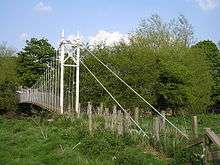
- The Upper House. Built as a Public House pre 1849.[45] The village Quoits Court was behind the Pub until 2003.
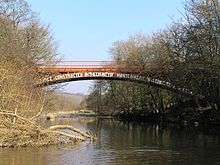 River Severn, Brynderwen road bridge - geograph.org.uk - 659348
River Severn, Brynderwen road bridge - geograph.org.uk - 659348
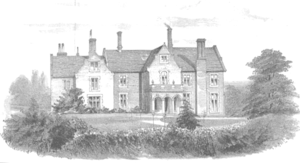
- Brynderwen Bridge - in the old Llandyssil parish, close to Abermule. A single 109-ft span across the Severn (and a smaller span across the canal) on five iron girders. Designed by Thomas Penson The openwork lettering on the outer ones reads 'This second iron bridge constructed in the county of Montgomery was erected in the year 1852'; 'Thomas Penson, County Surveyor'; 'Brymbo Company, Ironfounders'. The bridge came from Brymbo Ironworks, later steelworks, near Wrexham and would have been transported to the site by the Montgomeryshire Canal. Grade II* listed.[46]
- Fron Footbridge. An elegant iron suspension footbridge over the river Severn taking a footpath from Severn Villa to Lower Llegodig Farm. Built in 1926 by David Rowell & Co London (Westminster) bridge builders in 1926.
- Middle Llegodig, Timber-framed lobby-entry house of c. 1700, a late example of its type. In the later C18, the eaves were raised and a matching bay added to the right.
- Fronfraith Hall, designed by James Pickard of Shrewsbury, c1860 for ?Morris Jones. West wing burnt down in 1966.[47]
Quoiting in Llandyssil
Playing Quoits was a widespread pastime in many rural areas. It had largely died in much of England by the 2nd World War, but after the War enjoyed a revival in Mid-Wales when the quoits were made by a light engineering company in Newtown. In Llandyssil the “Old” or Long Quoits rules were followed. The quoits court was moved to behind the Upper House Public House by 1983, when an international game was played between Wales and Scotland. The Welsh team was captained by Glyn Owen of Llandyssil and other village players were Les Owen and George Mills. The Welsh team lost to Scotland. In the 1991 International match at Llandyssil, when Les Owen was in the team, Wales convincingly beat Scotland 252 to 83. The last championship match was held at Llandyssil in 2003, after which the court was closed. It is to be hoped that the sport might be revived in Llandyssil in the future.[48] [49]
Sheep Dog Trials
The 2012 Welsh National Sheep Dog Trials were held on the field by Llandyssil bridge at Henfron, Llandyssil, between 19 and 21 July 2012 by kind permission of Mr A. & Mrs S. Harding. This brought the village much publicity and was greatly enjoyed by local people[50]
Notable People
- John Billington (1936- ) British Junior High Jump Champion. AAA championships at Birmingham, 1954, when he cleared 6'0" (1.83metres).[51]
- Senator Rupert Davies (1879-1967), Canadian politician and newspaper editor, who was born in Welshpool, purchased Fronfraith Hall in 1932 and continued to use it as his home in Wales until he sold it in 1948.[52]
- Diz Disley (1931–2010), jazz guitarist. Lived in Oak Cottages in the 1930s.
- Henry Powell Ffoulkes (1815–1886). Rector of Llandyssil 1857–1879 and Archdeacon of Montgomery 1861–1886. Ffoulkes demolished the old Church in Llandyssil, amid considerable criticism.[38] He built the new church on its present site in 1863 at the cost of £3000. He also arranged for the building of the school and schoolhouse. He was a member of the Oxford Movement. A manuscript history of Llandyssil by Foulkes has recently been deposited in the Powys County Archives.[53]
- Peter Warlock - alias Philip Heseltine (1894–1930). Composer. Lived at Cefn Bryntalch. Composed many of his more important works there and played the organ in Llandyssil Church.
- Nigel Heseltine (1916–1995), writer and colonial administrator. An illegitimate son of Peter Warlock, who was brought up by the Buckley Jones family at Cefn Bryntalch[54]
- Rear Admiral Sir Charles Thomas Jones(1778–1853), third son of Charles Thomas Jones of Fronfraith. Saw distinguished service in the Royal Navy and was knighted in 1809. High Sheriff of Montgomeryshire 1832.[55]
- Brigadier General Lumley O W Jones (1887–1918), son of Richard and Catherine Jones of Cefn Bryntalch. Brigadier General commanding the 13th Infantry Brigade. Chevalier of the Legion of Honour (France) Died of pneumonia 14 September 1918 aged 41 and buried at the Bagneux British Cemetery at Gezaincourt. He had started the war as a captain in 2nd Essex Regiment and took part in nearly every battle on the Western Front. He was the last of 12 British General Officers to die on the Somme[56][57]

- Richard Morgan. Lived at Fronfraith. M P for Montgomery Boroughs 1592-3. He was married to Margaret Lloyd, daughter of Thomas Lloyd of Gwernabuarth
- Robert Morgan (1608–1673). Third son of Richard Morgan of Frofraith. In 1660 he became Archdeacon of Merioneth and he was consecrated Bishop of Bangor in 1666.
- George Thomas (1786–1859), writer and poet. In 1817 he married Bridget Stoakes of Kerry at Llandyssil and lived for the remainder of his life in the parish at Bank Farm. Clerk to the Governors of the Montgomery Workhouse (Camlad House) and also observed the Chartist Uprisings, about which he wrote a poem. He became the first postmaster of Llandyssil. In 1817 he wrote a poem about Otter Hunting, and his involvement in the sport with John Lloyd of the Court, Abermule is commemorated by a painting in the National Museum of Wales.[58]
- Iolo Williams, (1962-) Naturalist and television presenter. Lives in Llandyssil.[59]
Llandyssil Gallery
|
References
- ↑ "Community population 2011". Retrieved 10 November 2015.
- ↑ http://www.llandyssil-powys.co.uk/ The population figures are approximate because the 2001 Census figures do not coincide with the historic boundaries of the parish
- ↑ English E (ed) 1999 "A Collected History of the Communities of Llandyssil, Abermule and Llanmerewig".
- ↑ Bartrum P C “A Welsh Classical Dictionary: People in History and Legend up to about A.D. 1000”, National Library of Wales, 1993, 630. Tysul’s full name was Tysul ap Corun ap Cunedda - or son of Corun, son of Cunedda
- ↑ Thomas D R The History of the Diocese of St Asaph, Vol I, Caxton Press, Oswestry 1908 (2 ed.),524.
- ↑ “Bartrum”, 522-524.
- ↑ ’‘Thomas’’ Vol 1, 524,
- ↑ "Thomas" Vol 1, 524
- ↑ “English”, unpaginated. This provides a very detailed history of the Parish and the successor Community Council,
- ↑ http://www. history.powys.org.uk/school1/primhome.shtm. "Montgomery and the border district: Victorian Powys”. Powys Digital History Project. This gives information about the census returns - which has been supplemented with information from local directories
- ↑ Pryce W R T “Changing Language Geographies of Montgomeryshire c1749-1991” in Jenkins D (ed) “The Historical Atlas of Montgomeryshire”, Powysland Club, Welshpool 1999, 118
- ↑ RCHMW : An Inventory of Ancient Monuments Volume 1, County of Montgomery, HMSO, 1911, 77,
- ↑ http://www.www.cpat.org.uk/ycom/mont/llandyssil.pdf.
- ↑ Silvester, Robert J , 2011, Recent Research on Late Prehistoric and Romano-British Enclosures in Montgomeryshire , "The Montgomeryshire Collections" : 99 : 1-26. This provides the most recent survey of the Llandyssil earthworks in their Montgomeryshire context
- ↑ Gibson, A M & Musson, C R , 1990 , A cropmark enclosure and a sherd of later Neolithic pottery from Brynderwen, Llandyssil, Powys , The Montgomeryshire Collections : 78 : 11-15
- ↑ “RCHMW” : 77, no 385, no386
- ↑ http://www://cofiadurcahcymru.org.uk/arch/cpat/english/cpat_interface.html CPAT PRN187
- ↑ http://www://cofiadurcahcymru.org.uk/arch/cpat/english/cpat_interface.html CPAT PRN3645
- ↑ http://www.english-heritage.org.uk/.../iha-banjo-enclosures/banjoenclosures.pdf
- ↑ Chris Musson “Wales from the Air: Patterns of Past and Present” RCAHMW c.1996, 133, excellent air photograph.
- ↑ ”Musson”, 87
- ↑ Britnell, W J & Thomas, D , 2010 , Trial excavations on defended enclosure sites in the Llandyssil area of Montgomeryshire in 1993-94 CPAT Report 1042
- ↑ "Silvester" 2011, 2-4, fig2
- ↑ http://www.cofiadurcahcymru.org.uk/arch/cpat/english/cpat_interface.html PRN 3717
- ↑ http://www.archwilio.org.uk CPAT PRN 1822
- 1 2 "Britnell & Thomas" 2010
- ↑ "Silvester" 2011, 19
- ↑ http://www.cofiadurcahcymru.org.uk/arch/cpat/english/cpat_interface.html CPAT PRN 3722
- ↑ http://www.cofiadurcahcymru.org.uk/arch/cpat/english/cpat_interface.html CPAT PRN 155
- ↑ "Silvester" 2011, 16-17
- ↑ http://www.cofiadurcahcymru.org.uk/arch/cpat/english/cpat_interface.html CPAT PRN7500
- ↑ "Silvester" 2011, 19, fig11, for plan of site
- ↑ “Musson” 88-89, with excellent aerial photograph pf the Roman fort
- ↑ RCHMW : “An Inventory of Ancient Monuments Volume 1, County of Montgomery”, HMSO, 1911, 77, no 386
- ↑ http://www.Coflein NPRN 306271
- ↑ RCHMW : An Inventory of Ancient Monuments Volume 1, County of Montgomery, HMSO, 1911, 77, no 387
- ↑ Musson C, “Montgomeryshire Past and Present from the Air”, The Powysland Club, 2011, 93, Col. Plate
- 1 2 "Archaeologia Cambrensis" 125-132 and 269-272
- ↑ "Thomas" 524-529
- ↑ "Thomas" 524-529
- ↑ Haslam R Powys: The Buildings of Wales Penguin, London 1979, 75
- ↑ Foulkes Parish Notes, Llandyssil Church Records, Powys County Archives
- ↑ “Llandyssil Rectory: its architecture and building history” Montgomeryshire Collections, Vol. 90, 2002, 99-108.
- ↑ Peter Smith "Houses of the Welsh Countryside" 2nd ed, 1988, HMSO/RCAHMW, fig. 177a
- ↑ shown on Llandyssil Tithe Map of 1849- photocopy in Powys Archives, Llandrindod
- ↑ C. R. Anthony “Penson’s Progress: the work of a 19th-century county surveyor”, Montgomeryshire Collections, 1995, Vol 83, 115-175.
- ↑ "English" Section 6.1
- ↑ http://www.lindahome.co.uk/Quoits1/ABindex.htm
- ↑ The History of Quoits in Wales http://www.ukquoits.org
- ↑ http://www.sheepdogchampionships.co.uk/welsh/2012.htm
- ↑ htmp://www.gbr athletics.com/bc/bc3.htm
- ↑ “English’’, 6, section 1
- ↑ Brown R L , Henry Powell Ffoulkes, Archdeacon of Montgomery. The Montgomeryshire Collectons, Vol 94, 2006, 131-142
- ↑ Meic Stephens (ed) "The New Companion to the Literature of Wales", 2nd edition, UWP, 1998, 317
- ↑ Richard Williams “Montgomeryshire Worthies", Newtown (1884), 59
- ↑ http://www. twgpp.org/information.php?id=2776855, with photograph of headstone
- ↑ http://www.ww1wargraves.co.uk/ww1_cemeteries/ww1_cemetery_b.asp
- ↑ Frazer Thomas. George Thomas of Llandyssil, 1786–1859. The Montgomeryshire Collectons, Vol 97, 2009, 101-121
- ↑ "TV presenter Iolo Williams says 'sign the petition'", County Times (Welshpool), 13 May 2013.
External links
| Wikimedia Commons has media related to Llandyssil. |
- Llandyssil Community Trust, Village Hall and Dragonfest
- Local history resources for Llandyssil
- Homepage for Abermule with Llandyssil Community Council
- Details of the recently demolished brick arch in the garden at Brooklyn, opposite the Church
- Photograghs of Llandyssil
- Listed buildings in Abermule with Llandyssil Community Council
- Records held by Powys County Archives
- Victorian Powys- useful information for Llandyssill given in the Montgomery Town section
- Indexed database for archaeological finds in under Llandyssil Community entry.
- Photos of Llandyssil and surrounding area on geograph





.jpg)
